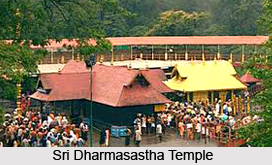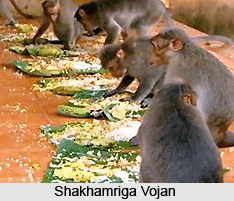 Sabarimala is a famous temple in Kerala, which is also a well-known pilgrimage centre. It is the `Sacred Abode of Lord Ayyappa` and one of the most important Hindu pilgrim centres in the country as well. The temple is situated high at the Sahyadri Mountains in Western Ghat and is in the midst of 18 hills. The location of the Sabarimala temple is the Sahya hilly regions of Kerala in Pathanamthitta District. It is situated on a hilltop at an altitude of 1260 m/4135 ft. above mean sea level, and is surrounded by mountains and dense forests.
Sabarimala is a famous temple in Kerala, which is also a well-known pilgrimage centre. It is the `Sacred Abode of Lord Ayyappa` and one of the most important Hindu pilgrim centres in the country as well. The temple is situated high at the Sahyadri Mountains in Western Ghat and is in the midst of 18 hills. The location of the Sabarimala temple is the Sahya hilly regions of Kerala in Pathanamthitta District. It is situated on a hilltop at an altitude of 1260 m/4135 ft. above mean sea level, and is surrounded by mountains and dense forests.
The holy place of worship is located amidst dense forests in the uneven tracts of Western Ghats. This area is inhabited by various wildlife species. Millions of pilgrims from all over the Country assemble here during the most arduous festivals called as "Vishu Vilakku` in the month of April, `Mandalapooja`, Vrichikam Dhanu in the months of November - December and `Makaravilakku` in mid January, coinciding with Sankramam.
The Sabarimala shrine is the most important and popular of the Sastha temples in Kerala. It is also the most significant because the pilgrimage to the shrine symbolises the struggle of the individual soul in its onward journey to the abode of bliss and beatitude. The path of the spiritual aspirant is always long, arduous arid hazardous.
History of Sri Dharmasastha Temple
As far as history is concerned, it revolves around the troubled times that prevailed in the kingdom of Pandalam at the very early period when the depredations of a robber chief called Udayanan rocked the whole country. The hill tracts of the Western Ghats were dotted with several villages and each village had Ayyappa as the guardian deity. Udayanan and his followers, bent on defilement and plunder, laid waste to these villages and shrines including Sabarimala.
The purpose of the avatara of Lord Ayyappa was to restore order in the country and to renovate the temple in Sabari Hill. Ayyappa fulfilled the mission in due course and thereafter entered the sanctum sanctorum and disappeared. It is believed that He re-united with the Supreme. Thus the Sashta temple at Sabarimala has the additional halo of Ayyappa, a name which stirs the emotional chord in every heart.
The ever-effulgent and merciful Lord of Sabarimala has been a psychological refuge to millions who seek His darshan annually. He sheds light and peace as Kali Yuga varada. He is a giver of boons and helps mankind to cross the ocean of samsara.
Legends of Sri Dharmasastha Temple
There is a beautiful story related to the ancient Ayyappa deity. It is believed that Lord Shiva got attracted to `Mohini`, the form that Vishnu assumed during `Samudra Manthan`. Shiva surrendered to the beauty of Mohini and the child born out of the both was known as `Sashta`. He is also known as `Hariharaputra` as he was the son of Hari (Vishnu) and Hara (Shiva). He was later adopted by the ruler of Pandalam as he had no child and was named `Manikanta`. But later when his queen became pregnant, she tried to get rid of him. She pretended to be ill and sent her to the forest to bring the milk of a tigress as the only cure. There he went with a coconut and some food in a bundle and killed the demoness named Mahisha. In return Indra`s followers took the form of tigers and tigresses with cubs and followed Manikanta to the palace. The queen then realised her fault and asked forgiveness. Later, as per the request of the king, Manikanta took up his permanent shelter in Sabarimala, where the king built a temple for him.
 There is a belief that Lord Rama`s devotee Sabari was an ideal devotee and Lord Ayyappa wanted his pilgrims to honour the same attributes as that of Sabri. Therefore, the name of the hill, on which the temple is situated, became Sabari.
There is a belief that Lord Rama`s devotee Sabari was an ideal devotee and Lord Ayyappa wanted his pilgrims to honour the same attributes as that of Sabri. Therefore, the name of the hill, on which the temple is situated, became Sabari.
Deity of Sri Dharmasastha Temple
The advent of Dharma Sashta is unique in the annals of Hindu religion and peculiar to Kerala. Legend and history are so intermingled in the genesis of this deity that it is difficult to sift one from the other. According to some Puranas and folk-songs of Kerala, He was born out of the union of Lord Vishnu and Lord Shiva.
Thus He is called Hariharaputra-Son of Vishnu (Hari) and Shiva (Hara)-and is regarded as the third son of Shiva, the other two being Lord Ganesha and Muruga or Lord Kartikeya.
Ayyappa thus embodies in Himself the qualities of both Shiva and Vishnu. He manifested Himself in various forms at various times. In Kerala, He descended as the child Manikanta (so called because of the golden bell around his neck). He was found on the banks of the river Pampa by the king of Pandalam who took the child to his kingdom. He was brought up with love and care as the king and queen was childless. Subsequently, the queen gave birth to a son and both the children grew up as brothers.
Sri Dharmasastha Temple as a unique Pilgrimage place
The pilgrimage to Sabari is unique in several ways. First there is the physical and mental cleansing of the devotees by the hard penance (vritham) they have to observe for 41 days preceding the pilgrimage. During this period they have to observe strict abstinence from mundane pleasures-a penance unique to Kerala.
Shouting of Saranam (surrender to God) is a prominent feature of the pilgrimage. Then there is the long arduous trek through mountains, valleys and forests abounding in wild animals. Of the three routes available to reach the sanctum, the one via Erumeli is the longest-about 72 km.-and the most arduous. This is also the most sacred because it is believed to have been traversed by Ayyappa Himself. The easiest route, however, is via Chalakayam near Pampa up to which vehicles ply nowadays. Hence this is preferred by the majority of pilgrims nowadays.
Peculiar again is the eighteen steps (Pathinettampadi) leading to the sanctum sanctorum. Nowhere the steps j of a temple are held as sacred as those at Sabarimala, Only those who observe the 41-day austerities and Oarry the Irumudi can climb these steps.
How to reach Sri Dharmasastha Temple
For the visitors from outside the state and the country, there is an international airport in Thiruvananthapuram. This is the nearest airport and is situated 175 km from Sabarimala. The other mode of transportation like car or bus is also available. These go via Chalakayam town or more intensively through the mountain trails commencing from Erumeli Township and climbing over the Karimala Mountains bare foot (close to 50 km). But the pilgrims can take their vehicles up to Pampa. After that, the pilgrims need to go on a path about 4 km up a steep hill. But porter carried chairs are available for aged and handicapped pilgrims. The nearest railway stations are Kottayam and Chengannur.
The path of Sabarimala is now fully cemented and there are many shops of food and medical aids available on the side of the path. This is not like earlier one, which passed through a dense forest. A place can be found near the temple dedicated to `Vavar`, a Muslim associate of Ayappan. The temple remains open only on few special days like at the time of `Mandalapooja` (November 15 to December 15), `Makaravilakku` (January 15), Vishnu (April 15) and on the beginning of every month in the Malayalam calendar.






